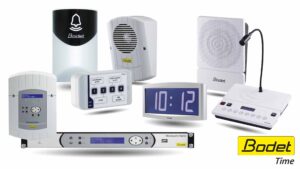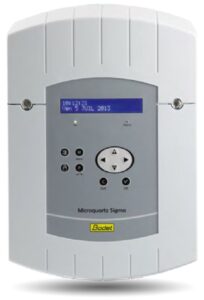 A time signalling system is an important component of a school, indicating when lessons and breaks begin, and it can also be used for alarms. The possibilities with these systems are vast today. But which type of time signalling system is suitable for which application(s)? And what are the considerations for these different systems? This step-by-step guide helps in making that choice and highlights the key considerations.
A time signalling system is an important component of a school, indicating when lessons and breaks begin, and it can also be used for alarms. The possibilities with these systems are vast today. But which type of time signalling system is suitable for which application(s)? And what are the considerations for these different systems? This step-by-step guide helps in making that choice and highlights the key considerations.
Versatile Solutions with time signalling system
In practice, schools are often not aware of the modern capabilities of lesson time systems. Where previously a simple buzzer sufficed, there is now a demand for more pleasant sounds. Traditional time switches are still used but are often difficult to (re)program. Fortunately, with the Bodet Time Signalling Systems, this is a thing of the past.
With the Bodet system, you can use your own melodies, easily adjust programming, and create different zones. It also supports announcements, activating AMOK alarms, and much more. The accompanying Bodet Sigma software, which has the look and feel of Outlook Calendar, allows for easy programming of the school bell. Additionally, it simplifies scheduling for 10-minute meetings, holidays, study days, and special timetables with just a few clicks.
The versatility of the Bodet lesson time system is evident from the various solutions it offers:
- Melodys: Wireless solution
- Harmony: Audio over IP solution
- Harmony combined with a 100V system
- Harmony combined with 24V/230V horns
In short, the Bodet Bell and PA System is simple yet versatile, making it suitable for any situation.
Step-by-Step Guide to Time Signalling Systems
Purchasing a time signalling system is a significant investment for many schools and should be well-considered. It’s important to understand the requirements and what the system can offer. This step-by-step guide provides tips for selecting the right system.
We follow these steps:
- Gathering Information
- Projecting Speakers
- Zoning
- Master Clock
- Melody System Considerations
- Harmony (Audio over IP) System Considerations
- Harmony Combined with 100V System Considerations
- Harmony Combined with 24V/230V Horns Considerations
- Clocks
Each step is described below:
Step 1: Gathering Information
To determine the most suitable solution, gather information about the project. What are the requirements for the system? This includes several simple questions:
- Is broadcasting required?
- If yes, only possible with Bodet Harmony or Bodet Harmony combined with a 100V system.
- Should the system be wired or wireless?
- Wireless is only possible with the Bodet Melody system.
- Is it an existing or new project?
- Existing projects might need fewer speakers than new builds, which often have specific sound insulation requirements.
- Is there an existing 100V system?
- If yes, the Bodet Harmony system can be integrated with the existing sound system.
- Are there existing 24V or 230V horns?
- If yes, the Bodet Harmony system can be used with these horns, but custom melodies or friendly sounds are not possible.
- Should background music be playable?
- Background music is only possible with Bodet Harmony or Bodet Harmony combined with a 100V system.
Step 2: Projecting Speakers
Based on the answers from Step 1, choose the Bell and PA System that fits the requirements. Consider where the sound should be audible. If there are existing 24V or 230V horns, only the central equipment changes.
Sound Insulation: For all other solutions, consider speaker placement carefully due to sound insulation norms in new buildings. For existing buildings, only corridor speakers might be sufficient.
Sound Choice: The desired sound type also affects speaker placement. Previously, a loud bell sufficed, but now a more pleasant sound or melody is preferred. The choice of sound influences its audibility in different rooms.
Step 3: Zoning
Knowing which system meets the requirements (Step 1) and the importance of speaker projection (Step 2), consider zoning. Schools are often divided into zones, such as primary and upper levels in elementary schools.
Custom Melody and Programming: With schools merging, having different melodies for each school and custom schedules is beneficial. Zones can be separately programmed to minimize noise disturbance for neighbors.
Step 4: Master Clock
![]()

The Sigma master clock from Bodet is the system’s heart, regardless of the chosen solution, projection, or zoning. The programming is written on the master clock, ensuring system synchronization.
Time Synchronization: The master clock ensures accurate time, often synchronized with an NTP server or a DCF antenna for atomic clock precision. The system can also handle AMOK alarms, act as a time server, and control lighting.
Step 5: Melody System Considerations
The Bodet Melody system is wireless, using a master clock, a transmitter, and receivers. It sends a trigger signal to activate pre-programmed melodies, not audio, making it unsuitable for broadcasts.
Repeaters: Signal range can be an issue, mitigated by repeaters. Both repeaters and receivers operate on 230V, and connecting the master clock to the internet is recommended.
Step 6: Harmony (Audio over IP) System Considerations
The Bodet Harmony system is a wired solution using audio over IP, offering flexibility with up to 100 zones and custom melodies for each speaker. The system operates via Power over Ethernet (PoE).
Expansion: It can be expanded with announcement stations, buttons, relays, and clocks, managed via Bodet’s free software.
Step 7: Harmony Combined with 100V System Considerations
This system uses a master clock, network, and 100V amplifiers. The digital signal is converted to analog, less flexible than the full Harmony system, as control is per line-out rather than per speaker.
Step 8: Harmony Combined with 24V/230V Horns Considerations
Suitable for existing setups without speakers, this system involves a master clock and relay outputs, but it doesn’t support custom melodies or broadcasts.
Step 9: Clocks
Bodet offers a range of analog and digital clocks synchronized with the master clock for accurate time, requiring no manual adjustments for daylight savings. They can be powered by batteries, 230V, or PoE, and connected wirelessly or wired.
Need help choosing the right Time Signalling System?
Tau Audio Solutions can assist in finding the right solution for your project or situation. Contact our audio experts at +31 (0)50 549 90 90 or in**@ta*.nl for more information.